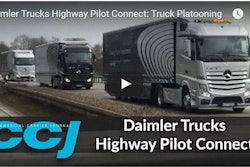 Daimler also unveiled its Highway Pilot Connect platooning technology.
Daimler also unveiled its Highway Pilot Connect platooning technology.At a global press event in Dusseldorf, Germany, Daimler Trucks announced its ambitions to leverage existing technologies to improve truck connectivity beyond today’s capabilities and drive efficiencies throughout the logistics supply chain.
“There is a revolution going on, and the truck is in its center,” said Wolfgang Bernhard, member of the Board of Management for Daimler AG, Daimler Trucks & Buses. “We have a vision of the future where the entire transportation process is completely seamless. Where the flow of goods on the road is mirrored by a flow of information from the internet in real time.”
Citing global road freight growth projections of three times their current levels by 2025, Daimler outlined its strategy is to create a connected truck environment that provides sophisticated real-time data exchange, greater efficiency and transparency throughout the supply chain.
“On average, a truck spends only one-third of its time driving,” said Bernhard. “The rest is spent waiting to get loaded or unloaded, at a service facility, stuck in traffic or at a rest area. Soon these can be problems of the past with connectivity. The connected truck can provide the real-time information that is now lacking.”
Bernhard envisions a supply chain with completely digital information exchange between driver and shipper, a Formula 1-like service environment with parts and technicians on-hand to make repairs as the truck arrives, automatic rest stop reservations and routing when the vehicle senses the driver is fatigued, and exchange of information between vehicles and infrastructure.
“Without the connected truck, information flows with the logistics network were sketchy and fragmented,” said Bernhard. “With the connected truck, the main data node is established and provides real-time information to all participants in the logistics network and turns that network into an information power grid.”
Highway Pilot Connect enables truck platooning
As an example of increased connectivity, Daimler debuted its Highway Pilot Connect, the next step in it quest for autonomous truck operation. In an on-highway demonstration on the Autobahn on the outskirts of town, Daimler showcased its new capabilities with a platoon of three Highway Pilot Connect-equipped Mercedes Actros trucks.

In the demonstration, the following distance is reduced from 50 meters to 15 meters when the three trucks link into a single platoon, which Daimler says can decrease emissions and improve the combined fuel efficiency of the three vehicles by as much as 7 percent (2 percent improvement for the lead truck, 11 percent for the second truck and 9 percent for the third truck).
When a Mercedes passenger car entered the gap between the second and third truck, the Highway Pilot Connect automatically increased the following distance of the third truck to 50 meters until the car exited the lane, after which the system automatically closed the gap back to 15 meters.
“Highway Pilot Connect is a perfect example to illustrate the possibilities in V2V communication,” said Sven Ennerst, head of product engineering & global procurement, Daimler Trucks. “Compared to Highway Pilot, Highway Pilot Connect unveils further fuel savings potential and reduces CO2 emissions and takes the burden off the shoulders of drivers on monotonous routes and will increase transport efficiencies in areas with low traffic density.”
How Highway Pilot Connect works
Highway Pilot Connect relies on a number of sensors found in Daimler’s Highway Pilot truck, including long-distance and short-range radars on the front grille capable of measuring vehicle speed to within 0.1 kilometer per hour and distance accuracy of 20 centimeters, as well as a windshield-mounted stereo camera with a 100-meter range that detects lane markings, overpass clearances and traffic signs.
Highway Pilot Connect adds a video camera mounted above the windshield that relays real-time traffic video from the lead truck to the two trailing vehicles to provide drivers with a clear view of traffic conditions ahead of the platoon. A separate control unit calculates driving strategy and provides necessary steering for all three vehicles using a hydraulic/electro-mechanical steering support.
An additional communication module exchanges information among the three trucks including vehicle type, size and weight (used to help determine the optimum order the trucks should be sequenced), as well as steering maneuvers, braking force requirements and other necessary data.
The frequency of data exchange among vehicles – which has a total range of 200 meters – depends on the speed of the platoon. In typical road and traffic conditions, the system transmits one message per second, but can send 10 messages per second when necessary.
In the cockpit, the driver can see the available connected trucks in the display and activate Highway Pilot Connect with a switch on the steering wheel. If a vehicle leaves the platoon by deactivating Highway Pilot Connect, the remaining vehicles in the platoon will close the gap.
“Platooning and Highway Pilot Connect are two key steps in trying to make sure we can bring about autonomous driving,” says Ennerst. “Highway Pilot Connect isn’t some far-away vision, it’s real already. But to make sure our customers and other traffic participants can benefit, we need a legislative and regulatory framework that will be more clear in years to come.”













